Kingdom Animalia Order Hymenoptera Genus Xylocopa Higher classification Carpenter bee | Phylum Arthropoda Family Apidae Scientific name Xylocopa varipuncta Rank Species | |
 | ||
Similar Carpenter bee, Bee, Insect, California carpenter bee, Apidae | ||
Golden male valley carpenter bee xylocopa varipuncta
The valley carpenter bee, Xylocopa varipuncta, is one of three species of carpenter bee found from western New Mexico to southern California. Females are a metallic black while males are fuzzy and gold with green eyes. They are the largest bees found in California, growing to around 1 inch (2.5 cm) in length.
Contents
- Golden male valley carpenter bee xylocopa varipuncta
- Taxonomy and Phylogeny
- Description and Identification
- Distribution and Habitat
- Life Cycle
- Nesting
- Male Behavior
- Attractive Pheromone
- Site Fidelity
- Female Behavior
- Mating Behavior
- Social Behavior
- Thermoregulation
- Use of Water
- Sting
- Pollination
- Enemies
- Human Importance
- References
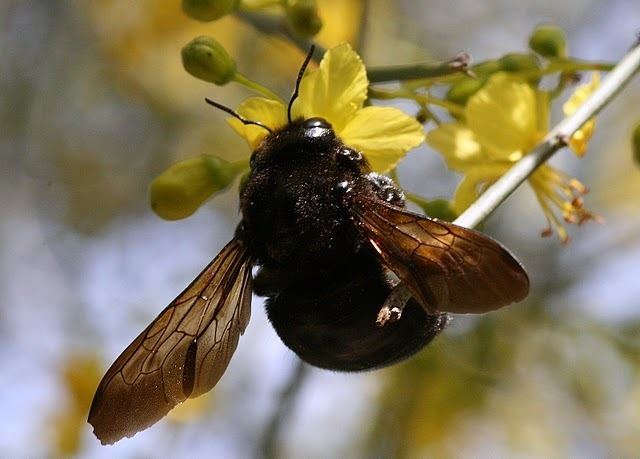
A distinguishing characteristic that uniquely separates X. varipuncta from other species of bees is their ability to thermoregulate. This allows them to fly at very high temperatures without overheating and at low temperatures without freezing. By modifying their foraging patterns and flying between different altitudes depending upon temperature, the valley carpenter bee is able to adapt to very different environments through predisposed behavioral patterns.
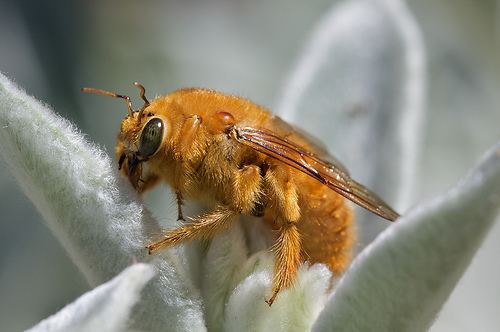
Taxonomy and Phylogeny
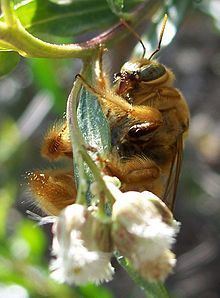
X. varipuncta is the largest native bee species alongside the bumble queens and are found in a diverse range of ecosystems from subtropical to temperate. The name "carpenter" comes from the fact that these bees have developed a habit of excavating inside a variety of woods. Like its close neighbor, Xylocopa virginica, X. varipuncta like to reside in fence posts and structural timbers and form small nests. Additionally, these large, hairy bees are named for the Central Valley in which they are commonly found, and for their ability to burrow into, and make their nests in, hardwood and telephone poles.

With 31 subgenera and 500 species identified under the Xylocopa genus, these sets of bees are large not only in size, but in numbers as well. Since the Xylocopa genus have varying body sizes (polymorphism) and mating systems differ across certain species, it is difficult to pinpoint the relationships among varying species.
Description and Identification
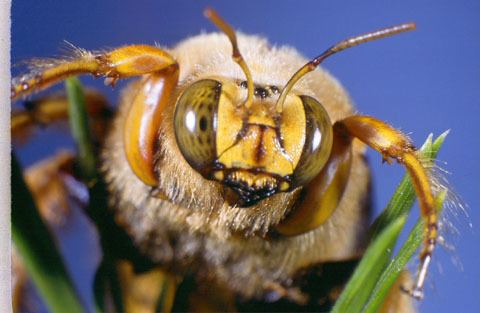
Female carpenter bees are black and male carpenter bees are characterized by their gold cover. Excellent pollinators, the carpenter bees are found all over the United States including valley and foothill areas. Additionally, they are not harmful and the males do not have stingers, which means they pose little harm to humans. They boast a large thoracic gland that is used to gather pheromones to attract mates, which suggests a lek is probable.
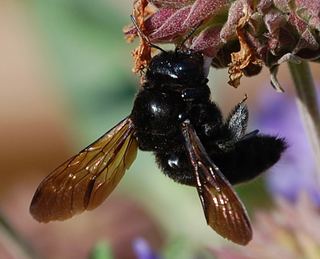
In terms of body size, X. varipuncta are 1 inch or 2.5 centimeters in length and are the largest bees found in California. Even though carpenter bees are good pollinators, deeper flowers are harder to access because they do not have any methods of reaching it. In order to pollinate, they use a buzzing method (grabs tube with its jaws and shakes ~100 times a second to get as much pollen as possible). As opposed to regular bumblebees, X. varipuncta has hairless abdomens while bumblebees have hairy abdomens. This characteristic allows the carpenter bees to break into the toughest flowers so they can pollinate them.
Distribution and Habitat
This particular species is found in the southwestern part of the United States and are rarely found in parts of Mexico. In America, they are found in Arizona, California, New Mexico, Nevada, Texas, and Utah and Costa Rica. They avoid painted or stained wood, however, in order to avoid the pains with penetrating the painted/stained surface in addition to the wood. The primary habitats of X. varipuncta are valleys and foothills with deciduous trees consisting of oaks. They are called “carpenter bees” because of the females’ ability to excavate tunnels in wood to overwinter as adults in the tunnels.
The bees will tunnel through wood with their mandibles, although they do not ingest the wood in the process. The tunnels average 6 to 10 in (15 to 25 cm) in length and consist of a linear series of partitioned cells. They prefer untreated or unpainted wood. The adult bees spend the winter in the tunnels. Most of X. varipuncta are solitary bees and they build most of their nests on tree stalks and rotting limbs.
Life Cycle
Young adult male and female bees hibernate in the tunnels during the winter. In the spring, they clean out and enlarge the old tunnels used during the Winter or make new ones as brood chambers. Each chamber contains a substance called "bee bread", which is a mixture of pollen and nectar used as food for the larvae. An egg is deposited on the food supply and each chamber is sealed off. “There are typically six to eight chambers created by the female and the larvae that hatch from the eggs complete their development and pupate”. Newly developed adult carpenter bees emerge in August and feed on nectar returning to the tunnels to over-winter and start the cycle over again.
Nesting
All nesting cycles for all species of Xylocopa show common features. The bees have a period of reproductive dormancy even in the presence of the other sex that occurs during the dry seasons. Or, they may enter into a non-reproductive phase during the cooler months. The second characteristic of nesting cycles is that the dormant females are unmated. Additionally, mating occurs after territorial flights by the males and before nest establishment.
Xylocopa species nest in dead wood, floral stalks, and bamboo stalks. Species are adaptable due to their ability to survive in various temperatures and nest in a variety of substrates. carpenter bees construct two main types of nests. First, they create unbranched or linear nests with tunnels that go in opposite directions from the entrance. The nests consist of hollow plant material that these bees take advantage of. The second type of nests the Xylocopa have are branched nests constructed of tree trunks or timber. Interestingly, the type of nests can influence schedule of brood production. In linear nests, there is a limited time-window available for cell provisioning; as a result, the youngest brood must be strong enough to withstand older bees crawling over them/stealing resources. Because the younger brood are in danger of having shorter life spans in the linear nests, this concept of provisioning is called the “ticking clock”. In contrast, branched nests are constructed within separate tunnels, which allows brood provisioning and development to occur without time restraint.
First-laid eggs produce the first bees to emerge as adults and these adults break all of the partitions in tunnel push the unhatched pupae to the far end of the nest. Lastly, emerging bees do not develop fully for one to several weeks in which they feed on pollen brought by the mother and closer relatives. Following they fully develop, the emerging bees may join the mother's nest, build a nest right next to the mother’s nest, or disperse and find their own territory to nest.
Male Behavior
Male carpenter bees do not exhibit parental care for their offspring and are polygynous. There are three forms of behavior that lead to polygynous behavior: female defense, resource defense, and male dominance polygyny. Males increase their frequency of mating by waiting at places with dense female populations, such as nest sites (female defense) and feeding sites (resource defense). In dense nest aggregations the male patrols the nest site and competes directly for each emerging female. Aggregations with widely spaced nests competition leads to territoriality either at the nest sites or near flowers, depending upon their relative availability.
Male insects might optimize their mate-locating activity through methods of the ideal free distribution theory. This theory states that the most fit individuals will seek to occupy the most resource rich territory and those that are less fit will have to occupy a resource lacking territory until both territories are filled. For species such as X. varipuncta, there are patches of different quality arising from “the continuous but variable input of mate-searching females over afternoons and flight seasons”.
Attractive Pheromone
The large male mesosomal gland of X. varipuncta produces volatile components, called pheromones, which are attractive to females. These pheromones are long-range attractants and are used as male advertisements. The large mesosomal gland is seasonally active and overwintering males have no detectable scent of the attractant, which further supports the evidence of it acting as an attractive mechanism. X. varipuncta mark the central area of their territories with the pheromones. Three observations were made that helped form this conclusion:
- Flying bees occasionally brush against leaves or twigs towards the center
- The “land and walk” behavior occurs at the focal area involving the application of the pheromone chemical
- Females fly to and pause on non-flowering plants that had been the focal area of the male where the attractant was placed.
Site Fidelity
There are various factors that affect X. varipuncta fidelity rates. First, high mortality rates of resident males is significantly correlated with frequent turnover rates and decreased site fidelity. Second, male density affects site fidelity. As the ratio of rivals to suitable territories rises, competition for territorial control increases, which leads to frequent turnover. In contrast, if there are few replacements for territory owners, there will be evidence of increasing site fidelity. For X. varipuncta, the prevalence of days of very low territorial occupation and a few days of high male density in “lek” conditions resulted in decreasing fidelity. Another aspect of the environment that affects site fidelity is the quality of territorial sites. Finally, fluctuating or declining territory value should reduce the extent of site fidelity. The extent to which female territorial preferences remain constant throughout the mating season will be very important in territory value. We can expect males to abandon territories at times when they no longer have the potential to produce offspring. It is also conceivable that in X. varipuncta, the quality of the male's sex pheromone may be a key feature determining his sexual attractiveness. Interestingly, most males of X. varipuncta did not exhibit site fidelity, while few males exhibited strong attachment to their original sites.
Female Behavior
Virgin females may make exploratory foraging flights and be attracted to visual and olfactory signals. Males may rely on similar cues rather than on actual food collection by females when choosing their territories. Female mate-searching behavior might involve waiting for the male at the flower on which she discovers his markings or a directed flight toward a marked spot from a distance.
Mating Behavior
Non-resource-based territoriality evolved from food source territoriality as a response to a low density of bees. The probability of a single male encountering females is very low, and the production of attractants by the male would be advantageous to both sexes. The attractants may be signals such as loud buzzing by the male and the addition of an odor to the flowers. The males may use these signals when patrolling along extended paths or hovering at a specific site. “At this point real male dominance polygyny begins, for males may produce quantitatively or qualitatively individual pheromonal signals that may reflect their fitness, and the female could react correspondingly by selecting among the males”. The use of pheromonal signals allows males to relocate their territories from resource sites to prominent sites such as hilltops, various protrusions, or trees. At this point, pheromones may direct the female into the territory founded by males. Short-range marking of the signal by the female bee attracts them to male territory just before copulation will occur. Competition among males for non resource sites may lead to adaptations that continue to evolve until one male has an advantage over the other.
Social Behavior
Among the Xylocopa, there have been various forms of sociality identified. In one species, a solitary female created a nest and made a brood consisting of three cells. The oldest daughter guarded the nest while the mother prepared a second brood of two to four bees. Then the mother died and the female took over the mother’s duties of brooding.
In another species, a period of inactivity was observed twice a year, with activity continuing thereafter. If the colony consisted of an active mother and her offspring, there was four to six weeks of cohabitation that allowed the mother to make a few brood cells while the daughters were still unmated. In a two-female nest, which could involve sisters, cohabitation lasted from five to fourteen weeks, and brood production was more than twice that in matrifilial nests.
In another species, certain adults competed for positioning in the nest opening because the first bees to return to the nest receive the most care and resources. Guarding, therefore, can be considered a side effect of competition. In about half of the nests the mother succeeded in raising at least one additional brood, but in the other half the daughter became dominant. In the latter case the mother either could be forced to leave or could remain as a guard. One mother remained a guard for three consecutive broods, while evicted mothers may establish successful nests elsewhere.
Xylocopa species have various social behavior and depending on the species, the social behavior differs greatly.
Thermoregulation
Xylocopa varipuncta maintain thoracic temperatures of 33.0 to 46.5 degrees Celsius while traveling through environments with 12.0 to 40.0 degrees Celsius. Since the thoracic temperature is not constant the bees are thermoregulating. There is physiological transfer of large amounts of heat to the abdomen and to the head during pre flight warming and thoracic heating. The temperature increase of the head is due to passive conduction, while the abdomen is due to physiological heat transfer throughout the body. In conclusion, “thermoregulation involves a strong reliance on convective cooling through increased flight speed”.
Carpenter bees have large heads, which present a larger surface area for convective cooling. The abdomen is also “well- suited for rapid convective heat loss because it is flattened dorso-ventral, and uninsulated”. Physiological heat transfer to head or abdomen would not be apparent from body temperatures due to the rapid convective cooling, especially at high air temperatures when flight speed increases.
Xylocopa have circulatory anatomy like honeybees and bumblebees. Like bumblebees, they have an aortic loop through the flight muscles that acts as a cooling coil allowing heat transfer to the blood, head, and abdomen. However, like honeybees, their aorta is also coiled in the petiole to prevent heat transfer to the abdomen.
A large part of the thermoregulation during flight in Xylocopa involves forced convection as a result of changes in flight speed, with active heat transfer to the abdomen and evaporative heat loss from the head at high temperatures.
Use of Water
Carpenter bees ingest excess water during nectar foraging or robbing. Analysis of nectar consumed by a similar species, X. capitata, shows that water is very concentrated in the nectar obtained. Nevertheless, their hemolymph is moderately concentrated and the urine is very dilute. This suggests that ions, rather than water, may be limiting for carpenter bees. This hypothesis is supported by the fact that bees excrete water before and during flight. Also, they often engage in water evaporation from ingested nectar during the flight.
Sting
Only the females of the species have a stinger, and will only normally sting when provoked.
Pollination
Flowers are the sole source of food and water for the bees. The bees have long lifespans and inhabit a wide variety of geographical ranges, which allows to visit a number of different plants. The bees also have a pattern of visiting certain plants at various times throughout the day.
In terms of acquiring the nectar from the flowers, the bees use two techniques. First, they obtain nectar by reaching for the source from within or upon the flower using its limbs. However, if the flower nectar is too deep within the flower and cannot be accessed, the bees use “nectar theft” or “robbery” imbibing the nectar through a slit they make in the base of the petals to steal the nectar.
Some flowers protect themselves from robbery with adaptive structures such as strong plant walls or by producing extrafloral nectar which is visited by ants that inhibit the bees from robbing the nectar. Ant guards can only be effective for certain bee species.
To collect pollen, they actively bush off their anthers on the petals or by using the buzz pollination method which the pollen is released from anther following vibration of the indirect flight muscles of the bee.
Carpenter bees pollinate passionflower both in their native habitats and in commercial settings. Interestingly, they provide better pollination than honey bees for the passionflower. For some species, their foraging activity led to an increase in tomato weight by 10% relative to a combination of wind and insect pollination. This efficiency of pollination by the carpenter bees in pollinating tomatoes is drastically improved by their ability to buzz the anthers, which is unique to the carpenter bees. In a study done in Israel, honeydew melons pollinated by X. pubescens, relative of X. varipuncta, was three times higher compared to honey bee pollination. As a result, one can clearly see the importance these bees can have commercially in producing better fruits as well. Carpenter bees are important pollinators of cotton in Pakistan, India, and Egypt as well. X. varipuncta is compared favorably with honey bees as pollinators of cotton in field cages in the United States.
Enemies
The Xylocopa's large size and ability to store high energy foods makes them an attractive target for enemies. The enemies include 19 different predators and 15 parasites. The predators include ants, termites, and insectivores. The following are just some of the numerous predators: humans, baboons, orioles, wrens, crows, Woodpeckers, squirrels, Termites, and Ants. Additionally, some parasites include Asilidae, Bombyliidae, conopidae, Encyrtidae, Evaniidae, Leucospidae, Perilampidae, Torymidae, and Laelapidae.
Because most Xylocopa species are not as aggressive, the defense is primarily carried out by building well constructed cell partitions, blocking nest entrance in various ways, covering the cell partitions with liquid substances, or expelling all the progeny of a nest that has been disturbed.
Human Importance
Carpenter bees are notorious for damaging man-made “wooden structures, lead cables, fiberglass insulation, and Styrofoam”. Despite their large size and widespread distribution they do not cause severe damage because of their slow development, reuse of nests, and preference of species to develop in trees rather than in structural timber. The carpenter bees are essential due to their pollination ability of various species of flowers. Their large body size makes them the natural pollinators of large flowers such as Passiflora and Luffa species and of other fruits and vegetables. In a Brazilian study, a single carpenter bee pollinated as many Passiflora flowers as an entire colony of honey bees. A major reason for the failure of attempted Xylocopa utilization in pollination has probably been that no food sources were available to the bees once the crop to be pollinated was no longer in bloom. However, the large carpenter bees have the potential to become an important aid in agricultural systems, especially where honey bees are not as effective. Before agricultural benefits can be gained from carpenter bees the management of semi wild populations must first be achieved.
